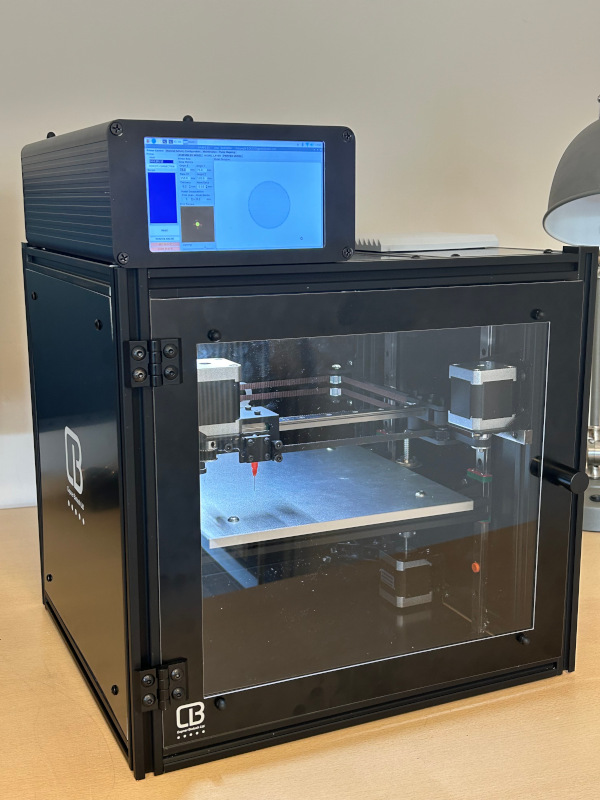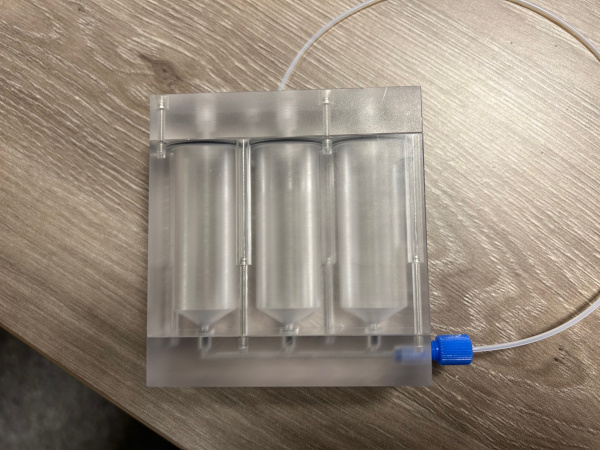GRAPE S1 4D defines the new benchmark in extrusion bioprinting both in terms of printing accuracy, biomaterial dispensing environment and small bioprinter footprint 450mm height, 385mm width and 350mm depth. GRAPE S1 4D brings biofabrication to your desk enabling the bioprinting of multiple user derived bioINKs within a cleanroom type environment employing multiple temperature zones. GRAPE S1 4D employs microfluidics and does not require any external compressors and/or laboratory modifications. GRAPE S1 4D comes with a range of available print nozzle diameters ranging from 0.25mm to 0.05mm coupled with nozzle positional delta movement resolution of 0.01mm; together with GRAPE® 3D modelling software and remote control application.
GRAPE S1 4D
Bioprinting Approach
Copner Biotech’s novel approach to bioprinting couples microfluidic droplet deposition with raster-style,
sequential printer head movement. This method of deposition is firstly optimised to the user’s own BioINKs
via our, ‘droplet optimisation protocol’ before users can print personalised 3D constructs.
Microfluidic droplet deposition performed in this manner unlocks a new level of precision and control
during the bioprinting process.
User derived BioINKs
GRAPE S1 4D prints using biomaterials collected from our proprietary interchangeable microfluidic reservoirs, allowing users
to utilise biomaterial/cell combinations (BioINKs) of their choice.
These interchangable microfluidic reservoirs enable users to employ in essence an unlimited number of materials during the biofabrication process.
Each interchangable microfluidic reservoir encompasses three vials capable of holding BioINK and/or BioCLEAN materials.
This unique ability of GRAPE S1 to allow
user’s own materials has opened a new level of bioprinting freedom, empowering the research community
to push the boundaries of 4D extrusion bioprinting further than before.
Environment
GRAPE S1 4D provides a cleanroom type enviroment employing multiple configurable temperature zones to optimise your biofabrication process.
Next Generation Software Control
Whilst other bioprinting systems rely on STL files and g.code, Copner Biotech’s next generation bioprinters utilise graphical rectangular actual positional encoding GRAPE® files. GRAPE® was developed to address the key issues associated with STL and g.code procedures currently used in the market today. These issues include, but are not limited to, troublesome data approximations, modelling anomalies and low levels of precision in bioprinted constructs.
Our novel and proprietary GRAPE® 3D modelling format allow users to model and print highly precise 3D constructs, with high batch-to-batch consistency. With our next generation 3D modelling software, users can design and create complex, microarchitectures directly applicable to 3D cell culture and tissue engineering applications. From here, GRAPE® files are directly read and printed by the GRAPE S1 system, cutting out the need for tedious and troublesome slicer software.
Enables users to print complex microarchitectures optionally employing different BioINKs for some or all of the microarchitecture print layers.
GRAPE® Technology - Renderable Biofabrication®
Disclaimer
Users must ensure suitability of our product(s) in their application prior to use.
Products conform solely to the information contained in this and other related Copner Biotech Ltd publications.
The information contained in this publication is based on our research and development work and is to the
best of our knowledge true and accurate. Copner Biotech Ltd reserves the right to make changes to
specifications and information related to the products at any time. Products are not validated for
human or animal diagnostic nor therapeutic use but for laboratory, research or further manufacturing use only,
unless otherwise specified..


